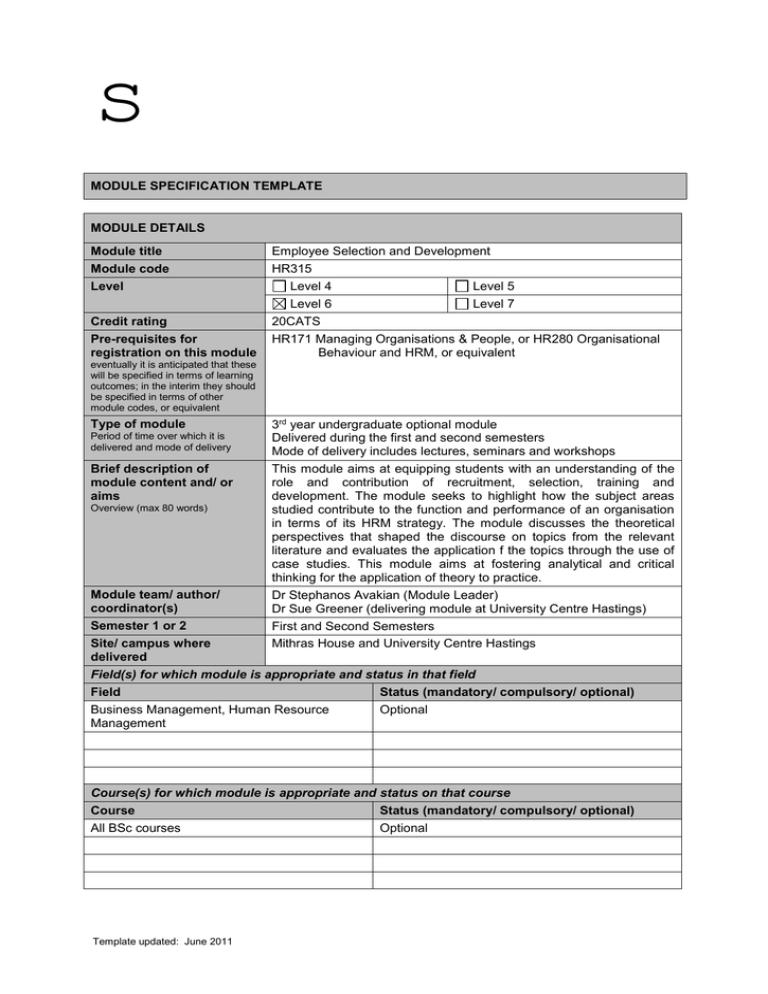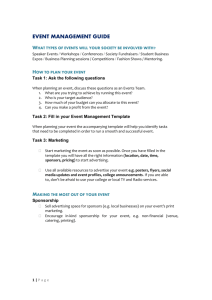Employee Selection and Development
advertisement

s MODULE SPECIFICATION TEMPLATE MODULE DETAILS Module title Module code Level Employee Selection and Development HR315 Level 4 Level 5 Credit rating Pre-requisites for registration on this module Level 6 Level 7 20CATS HR171 Managing Organisations & People, or HR280 Organisational Behaviour and HRM, or equivalent eventually it is anticipated that these will be specified in terms of learning outcomes; in the interim they should be specified in terms of other module codes, or equivalent Type of module Period of time over which it is delivered and mode of delivery Brief description of module content and/ or aims Overview (max 80 words) 3rd year undergraduate optional module Delivered during the first and second semesters Mode of delivery includes lectures, seminars and workshops This module aims at equipping students with an understanding of the role and contribution of recruitment, selection, training and development. The module seeks to highlight how the subject areas studied contribute to the function and performance of an organisation in terms of its HRM strategy. The module discusses the theoretical perspectives that shaped the discourse on topics from the relevant literature and evaluates the application f the topics through the use of case studies. This module aims at fostering analytical and critical thinking for the application of theory to practice. Dr Stephanos Avakian (Module Leader) Dr Sue Greener (delivering module at University Centre Hastings) First and Second Semesters Mithras House and University Centre Hastings Module team/ author/ coordinator(s) Semester 1 or 2 Site/ campus where delivered Field(s) for which module is appropriate and status in that field Field Status (mandatory/ compulsory/ optional) Business Management, Human Resource Management Optional Course(s) for which module is appropriate and status on that course Course Status (mandatory/ compulsory/ optional) All BSc courses Optional Template updated: June 2011 MODULE AIMS, ASSESSMENT AND SUPPORT Aims Learning outcomes/ objectives Content On completion of this module students should be able to: Show understanding of the importance of a range of methods and sources of recruitment and the different ways in which such methods are exercised, including social networking tools. Demonstrate knowledge of the different selection methods used as well as their advantages and disadvantages. Ability to explain how the selection process can be understood with reference to the key theoretical perspectives which underpin the assumptions for evidence of ‘fitness’ for work role. Discuss the growing importance of the discourse on Human Resource Development and its impact on corporate strategy with respect to case examples. Demonstrate understanding of the role and effectiveness of training and other development methods for improving organisational efficiency. Show understanding of the design and application of e-learning practices and their contribution to organisational learning and development. Understand the increasing impact of internationalization (e.g migration of workers between countries, outsourcing, crosscultural and cross-functional issues) on recruitment and selection, and training and development Demonstrate knowledge of the use of performance management related schemes: their advantages and disadvantages. Recruitment The influence of the macro-environmental (Political, Sociocultural, Technological, Economic) forces on recruitment practices The impact of labour market trends on recruitment and its variation between countries The use and importance of job design - analysis - description and specification Differences between internal and external recruitment, their advantages and disadvantages. Importance of the global economic downturn in changing recruitment trends Evolving role of technology and the growing trend of erecruitment and social communication tools Recruitment trends as influenced by the migration of workers between countries. Selection The selection process through the use of biodata, psychometric and personality tests The nature of assumptions made between the functional, interpretive and critical perspectives, and the assumptions’ impact during the selection decision making process. The advantages and disadvantages of selection methods including interviews and assessment centres. The role of discrimination, diversity and the application of legislation on selection practices. The growing role of international migration and the challenges and opportunities this carries for employees and employers in selection. Performance Management - Reasons behind the growing importance of measuring performance Template updated: June 2011 - - Methods and tools for measuring and managing performance The difference between measuring and managing performance and its implications The relationship between rewards, performance and motivation on employees The use of technology for the design and implementation of performance management (e.g. electronic performance support systems (EPSS) Critical perspectives of performance management Training - The relationship between training and job efficiency - Different modes of training - The role and impact of Training Needs Analysis - The role of learning styles and their use for the design and delivery of training initiatives Dimensions of E-learning and blended learning and its contribution to training initiatives (e.g. computer aided assessment, stand alone e-learning packages, corporate learning management systems) - Synchronous and asynchronous communication through the use of online tools (Laurillard’s conversational model) Teaching and learning strategy Allocation of study hours to activities (including pre-module activities, contact time, private study time and assessment) Human Resource Development - The role of personal development and its relationship to corporate performance - Differences between training and other methods of development including coaching, mentoring, shadowing etc. - The need for strategic focus in learning and development - The use of career development and talent management schemes that seek to improve retention and productivity - The relationship of national and international vocational training, government policies on skills and their impact on personal development and corporate performance - The emphasis on practices that stimulate strategic development in relation to organisational learning and knowledge management Critical perspectives of human resource development and the emphasis on power and exploitation Lectures will be supported by weekly seminars to discuss relevant literature, research and practical activities selected and set by the tutors to reinforce appropriate learning. Lectures: 20 Open Learning: Seminars: 20 Self Study: 100 Workshops: Assessment:60 Total:200 Learning support Including indicative reading, computer packages, field trips etc Indicative reading: The latest editions of: Armstrong, M., Handbook of Human Resource Management. Kogan Page. Briscoe, R. D. and Schuler, S. R. International Human Resource Management. London and New York: Routledge Buckley, R., Caple, J., The Theory and Practice of Training. Kogan Page. Campbell, P. J. and Knapp, J. D. (Eds) Exploring the Limits of Personnel Selection and Classification. London: Lawrence Claydon, T. and Beardwell, J. (Eds.) Human Resource Management: A Contemporary Approach (5th edition), (Paperback) London: FT Prentice Hall Dowling, J. P., Festing, M.Engle, D. A. International Human Resource Management: Managing People in a Multinational Context. Template updated: June 2011 London: Thomson Erlbaum Heneman G. H. and Judge, A. T. Staffing Organizations (5th Edition). London: McGraw-Hill Kraiger, K. (Ed.) Creating, implementing, and maintaining effective training and development: State-of-the-art lessons for practice. San Francisco, CA: Jossey-Bass Journals Academy of Management Journal Academy of Management Review Administrative Science Quarterly California Management Review Career Development International Cross Cultural Management Education & Training Empowerment in Organizations European Journal of Vocational Training Executive Development Human Relations Human Resource Development International Human Resource Management International Digest Interactive Learning Environments International Journal of Career Management International Journal of Human Resource Management International Journal of Training and Development Journal of Management Studies Journal of Managerial Psychology Management Development Review Organisation Organisation Studies Participation and Empowerment: An International Journal Personnel Review Strategic Management Journal The Journal of Management Development Websites www.ihrim.org www.hrba.org www.cedefop.europa.eu www.cipd.co.uk www.euromonitor.com proquest.umi.com www.dti.gov.org Assessment tasks Including weighting of individual tasks Summative assignment 4500 words (80%) The assignment covers the areas of recruitment, selection and training and development. Peer Review (20%) Students are required to peer review each other’s assignments towards the end of the second semester. The students are assessed for the quality of feedback they provide to their classmates. EXAMINATION INFORMATION Area examination board External examiners Name Dr Beryl Badger Template updated: June 2011 Human Resource Management Date appointed 2009 QUALITY ASSURANCE Date of first approval 1997 Only complete where this is not the first version Date of last revision 2011 Only complete where this is not the first version Date of approval for this version Version number Modules replaced Specify codes of modules for which this is a replacement Template updated: June 2011 2011 6 n/a







